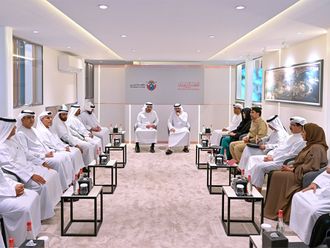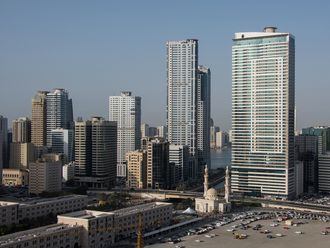A Pakistan International Airlines (PIA) flight with 205 people on board crash landed at Dubai International Airport yesterday early morning when part of its landing gear collapsed.
Flight PK231 from Islamabad via Peshawar veered off the side of the runway after the wheels on the right-hand side of the Airbus A300 gave way as it touched down at 2.09 am. The aircraft skidded along the ground and eventually came to rest in sand 50 metres from the runway.
A Dubai Civil Aviation Authority spokeswoman said 21 of the 193 passengers and 12 crew sustained minor injuries and were taken to the airport's medical centre for treatment, but were released shortly afterwards.
The incident caused the closure of the airport for over four hours, with 16 incoming flights having to be diverted to neighbouring airports in Sharjah, Abu Dhabi and Muscat, while departing flights were subject to delays.
The second runway at Dubai airport, which has been undergoing essential maintenance work and is due to be reopened on October 22, was brought into service temporarily and the airport reopened at 6.29 am with the departure of a Cathay Pacific flight.
The PIA plane seen at Dubai International Airport yesterday morning after it skidded off the runway while landing. – Picture: WAM |
Sheikh Ahmed bin Saeed Al Maktoum, President of the Department of Civil Aviation and Chairman of Emirates, who was at the scene with rescue workers yesterday, said: "Dubai International Airport emergency personnel acted promptly and all passengers and crew members are safe."
Initial investigations have shown that the landing gear on the right-hand side of the PIA aircraft collapsed when it touched down, causing the plane to veer off the runway.
The passengers and crew exited the plane using evacuation chutes when it came to a stop as emergency workers raced to the scene.
Brig. Ismail Al Gergawi, Director of Dubai Police's General Department of Airport and Ports, said: "Dubai Police worked in conjunction with medical and civil defence personnel to assist all passengers coming off the aircraft via the emergency chutes."
Shahid Latif, PIA Manager for the UAE and Middle East, said it was too early to say what caused the landing gear to collapse.
"The left-hand landing gear and the nose-gear stayed up as the aircraft continued for the best part of the runway before becoming stuck in the sand."
An operation to recover the stricken aircraft began yesterday morning with workers shoring up the soft sand before removing the plane from the side of the runway.
The UAE Federal Civil Aviation Authority, has launched an investigation into the crash, and will be working closely with Airbus and Pakistan International Airlines.
Mohammed Ghanem Al-Ghaith, Director General of the General Civil Aviation Authority explained: "The two black boxes will be sent to France within the next three days and we hope to have the peliminary results of the investigation by next week. We have also formed an official committee to investigate."
He stressed that the incident was caused by technical reasons. "This is a technical issue – terrorism is not involved at all and we are 100 per cent sure of this fact. We will also be able to prove it conclusively within the next few days."
The incident was the second involving a crash landing at Dubai airport in a month. An Aeroflot flight from Moscow to Dubai with 307 passengers and 15 crew on board 'belly-landed' on September 21, causing two of the engines on the Ilyushin 86 aircraft to burst into flames.
Nobody was seriously injured in that incident either, but it forced the closure of the airport for 13 hours, with 48 incoming flights having to be diverted to neighbouring airports.
Al Ghaith added that there were no links between the accidents, and said the chances of two crash landings happening within such a short time frame did not reflect the general reliability of modern aircraft.
"We cannot comment on the exact causes of the incident because investigations have only just begun. However, accidents do happen very rarely and the fact that these have occured so closely together is no reflection of the general trend. It certainly is very unusual.
"The response time for the emergency services was incredibly fast – in fact I would say it's our fastest to date.
"Dubai Civil Aviation teams were able to arrive at the scene within minutes because the accident happened within easy reach of the emergency services. Foam was being sprayed on the engines as the passengers were being evacuated and there was no fire.
"The accident personnel were alerted to the emergency by Air Traffic Control as the pilot was busy handling the aircraft and bringing it safely to the ground."











